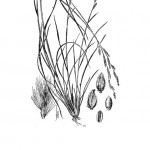Texas Cupgrass
Eriochloa sericea (Scheele) Munro ex Vasey
Poaceae
Description
Stems grow in large tufts. Leaves range from 4 to 11 inches or 10 to 28 cm in length. The blades are soft and lax. The ligule is a dense ring of straight hairs. Blooming occurs from April to October. The pale seed head has rows of fuzzy seeds borne on very short, hairy stems. Seeds are set in cups with ring-like bases. Once the seeds fall, the stem of the seed head has a zig-zag appearance. Texas Cupgrass is a perennial, warm-season, native ranging from 12 to 48 inches or 0.3 to 1.2 m tall. It does not grow through rhizomes. Instead, it grows into bunches with tangled roots attached to individual stalks. Good grazing for livestock. Fair grazing for wildlife. Seeds are consumed by small mammals and granivorous birds.Habitat
Grows best on hills and ridges, mostly in protected, moist areas. Native habitat includes prairies, plains, meadows, pastures, savannas, and woodland edges. Texas Cupgrass prefers full sun. Decreases with heavy grazing but will increase with proper use.Images
Plant Characteristics
Duration: Perennial
Stem Texture: Hairy
Growth Habit: Bunch grass, Grasses
Leaf Shape
 : Simple with Pinnate or Parallel Venation
: Simple with Pinnate or Parallel Venation
Season: Warm
Distribution
 : 02 - Gulf Prairies and Marshes, 03 - Post Oak Savannah, 04 - Blackland Prairies, 05 - Cross Timbers and Prairies, 06 - South Texas Plains, 07 - Edwards Plateau, 08 - Rolling Plains
: 02 - Gulf Prairies and Marshes, 03 - Post Oak Savannah, 04 - Blackland Prairies, 05 - Cross Timbers and Prairies, 06 - South Texas Plains, 07 - Edwards Plateau, 08 - Rolling Plains
Distributions
Distribution refers to the ecological region in Texas that a plant has been found. You can also view a clickable map.
Book: Know Your Grasses (B-182)
Collection: Grasses


